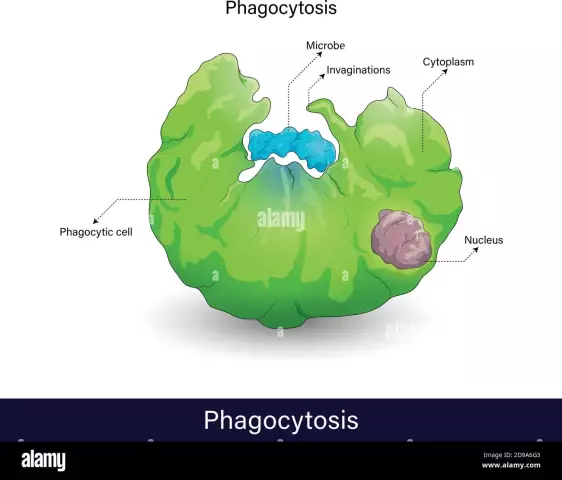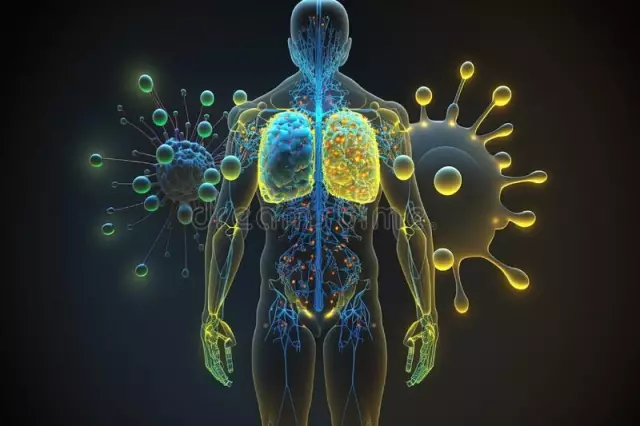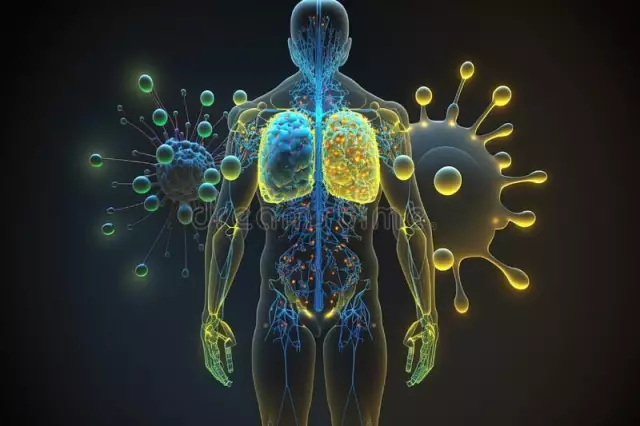- Author Curtis Blomfield [email protected].
- Public 2023-12-16 20:44.
- Last modified 2025-01-23 17:01.
Most often we learn from adults brought up by various TV shows that the immune system lives in the gut. It is important to wash everything, boil it, eat right, saturate the body with beneficial bacteria and stuff like that.
But that's not the only thing that matters for immunity. In 1908, the Russian scientist I. I. Mechnikov received the Nobel Prize in Physiology, telling (and proving) to the whole world about the presence in general and the importance in particular of phagocytosis in the immune system.

Phagocytosis
Protection of our body from harmful viruses and bacteria occurs in the blood. The general principle of operation is as follows: there are marker cells, they see the enemy and mark him, and the rescuer cells find the stranger by the marks and destroy them.
Phagocytosis is the process of destruction, that is, the absorption of harmful living cells and non-living particles by other organisms or special cells - phagocytes. There are 5 types of them. And the process itself takes about 3 hours and includes 8 stages.
Stages of phagocytosis

Let's take a closer look at what phagocytosis is. This process is veryorderly and systemic:
• first, the phagocyte notices the object of influence and moves towards it - this stage is called chemotaxis;
• having caught up with the object, the cell is firmly glued, attached to it, i.e. adheres;
• then starts to activate its shell - the outer membrane;
• now the actual phagocytosis itself begins: this phenomenon will be marked by the formation of pseudopodia around the object;
• Gradually the phagocyte encloses the harmful cell inside itself, under its membrane, so a phagosome is formed;
• at this stage phagosomes and lysosomes merge;
• now you can digest everything - destroy it;
• at the final stage, it remains only to throw away the products of digestion.
Everything! The process of destroying the harmful organism is completed, it died under the influence of strong digestive enzymes of the phagocyte or as a result of a respiratory explosion. Ours won!
Joking aside, but phagocytosis is a very important mechanism of the body's defense system, which is inherent in humans and animals, moreover, in vertebrates and invertebrates.
Characters

Not only phagocytes themselves are involved in phagocytosis. Although these active cells are always ready to fight, they would be absolutely useless without cytokines. After all, the phagocyte, so to speak, is blind. He himself does not distinguish between his own and others, or rather, he simply does not see anything.
Cytokines are signaling, a kind of guide for phagocytes. They have some great"vision", they perfectly understand who is who. Having noticed a virus or a bacterium, they glue a marker on it, by which, as if by smell, the phagocyte will find it.
The most important cytokines are the so-called transfer factor molecules. With their help, phagocytes not only find out where the enemy is, but also communicate with each other, call for help, wake up leukocytes.
When we get vaccinated, we train exactly cytokines, we teach them to recognize a new enemy.
Types of phagocytes
Cells capable of phagocytosis are divided into professional and non-professional phagocytes. Professionals are:
•

monocytes - belong to leukocytes, have the nickname "wipers", which they received for their unique ability to absorb (if I may say so, they have a very good appetite);
• macrophages are big eaters that consume dead and damaged cells and promote the formation of antibodies;
• Neutrophils are always the first to arrive at the site of infection. They are the most numerous, they neutralize enemies well, but they themselves also die at the same time (a kind of kamikaze). By the way, pus is dead neutrophils;
• dendrites - specialize in pathogens and work in contact with the environment, • mast cells are the progenitors of cytokines and scavengers of Gram-negative bacteria.






